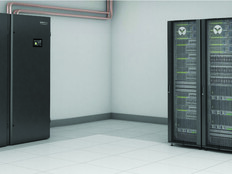How to Build Efficiencies Using Data Center Convergence
There’s nothing more critical to an organization’s operations than the data center. But in too many cases, the data center is inefficient, overprovisioned and underutilized.
In fact, enterprise data centers everywhere are reaching limits in power, cooling and space. At the same time, budget constraints are requiring organizations to rethink data center strategy.
Enter data center convergence. By creating a pool of virtualized server, storage and networking capacity — shared by multiple applications as well as lines of business — an agency can reduce the footprint of all elements of its data center.
By reducing the data center footprint, organizations can save on both capital expenditures and operational expenses, along with management, power and cooling — without sacrificing performance and reliability.
Convergence can also help bring IT projects in closer alignment with agency objectives. That can help the agency to gain advantage and efficiency via increased IT responsiveness and incremental tech capabilities.
Why Converge?
Anil Desai, an independent IT consultant, says three factors drive data center convergence: maximizing the value of data center assets, maximizing the utilization of those assets, and simplifying the management and administration of those assets.
Indeed, the case for convergence is readily apparent, particularly at a time when organizations are looking for ways to trim both operational and capital expenditures. And lying at the heart of most data center convergence efforts is virtualization.
“The vast majority of data center servers are highly underutilized. They’re using a fraction of their potential,” Desai says. “By consolidating all of those workloads onto a smaller number of servers by using technology such as server virtualization, it makes it a lot easier to gain much higher utilization rates for the hardware.”
Storage virtualization, on the other hand, involves the pooling of physical storage from multiple network storage devices into what appears to be a single device. Managed from a single console, storage virtualization removes the complexity and dramatically reduces the time involved with overseeing traditional direct-attached storage solutions.
And network virtualization is defined as combining hardware and software network resources into a single, software-based administrative body or virtual network. It involves platform virtualization, often combined with resource virtualization, and can be either external (combining many networks or parts of networks) or internal (providing network-like functionality to the software container on a single system).
Cost and Operational Benefits
Energy cost savings often top the list of converged data center benefits. Because virtualization eliminates hardware without sacrificing performance, less energy is used to run the same workload. Additionally, new data center equipment, such as blade servers running on IBM’s POWER7 processor, typically consumes less energy.
“If you introduce more energy-efficient hardware alongside server consolidation, you get a double benefit from that and have much lower energy usage,” says Ian Robinson, IBM virtualization product line manager. “This is very important for some of our customers on Wall Street. They literally tapped out the amount of energy available from the grid.”
Along with cost savings, convergence can improve the responsiveness of the IT department, making internal operations more efficient and cost-effective. Desai points out that virtualizing server, storage and network assets allows IT administrators to centrally manage those resources. It also makes it easier to implement critical functions.
“For storage resources, it makes sense to centralize all of that so they can do things like data duplication, thin provisioning, and support for disaster recovery and backup sites,” Desai says.
By eliminating many of the mundane chores associated with IT management, administrators can focus more on high-value tasks that are beneficial to an organization’s objectives. Along with that comes improved efficiency among end users and the ability to meet organizational demands.
“It provides the ability to get workloads provisioned much more rapidly,” Robinson says. “In the past, if an internal user wanted a new database or some sort of service, they would have to put a request in to the IT staff, and they would have to wait days or even weeks for the hardware to be acquired, for approvals on funding, to get everything set up and running.
“Once you move to that virtualized environment, you can send a request through e-mail, and it can be provisioned within minutes,” he adds. “It can make you a lot more responsive to changes in the marketplace because you can be much more responsive in a virtualized environment.”
Laying the Groundwork
Knowing the benefits of convergence is one thing. Knowing when you’re ready to converge — and what you need to converge — is another. Tim Mackey, senior director of product marketing at Citrix Systems, says organizations first need to know what assets they have and where those assets fit into their strategy.
“The longevity of the individual hardware components and the types of applications themselves will dictate it,” Mackey says. “Once you take a look at the types of applications and analyze how IT can align themselves with the agency needs more appropriately, you can identify the cost factors that are going to drive you toward greater virtualization, and by extension, greater consolidation of the data center resources.”
To assist, organizations can employ different monitoring and management tools to determine the current utilization of their assets, such as CPU and memory usage.
“What the enterprise tends to do is virtualize workloads one by one and then fine tune the settings,” Robinson says. “If you had some workloads that were CPU intensive, you wouldn’t put them all on the same server. Otherwise, they would all contend for the same limited CPU resource. You’d have a balanced mix of some workloads that are more CPU intensive, others that are more memory intensive, others that need a lot of storage.”
It’s also important to make sure your efforts meet compliance requirements, both internally and externally.
“As you’re doing consolidation, you’re changing the operating model, which may have an impact on the compliance model and the compliance regulations you might have to adhere to,” Mackey says. “It’s a case of making certain you identify the data elements that are going to be there as well as recovery models.”
While large organizations are equipped to handle entrenched regulations, new and evolving regulations involving data privacy keep IT departments on their toes, and any consolidation project must take those issues into account. Ideally, you should be able to enforce configuration policies and detect and resolve unplanned changes in any environment.
“Over the last few years, data privacy regulations have reared their heads such that some convergence projects might have a necessary component of re-architecture,” Mackey says. “There might be some types of data that were once passed in the clear in an internal network that now, because of data protection laws, need encryption or controlled access added.”








